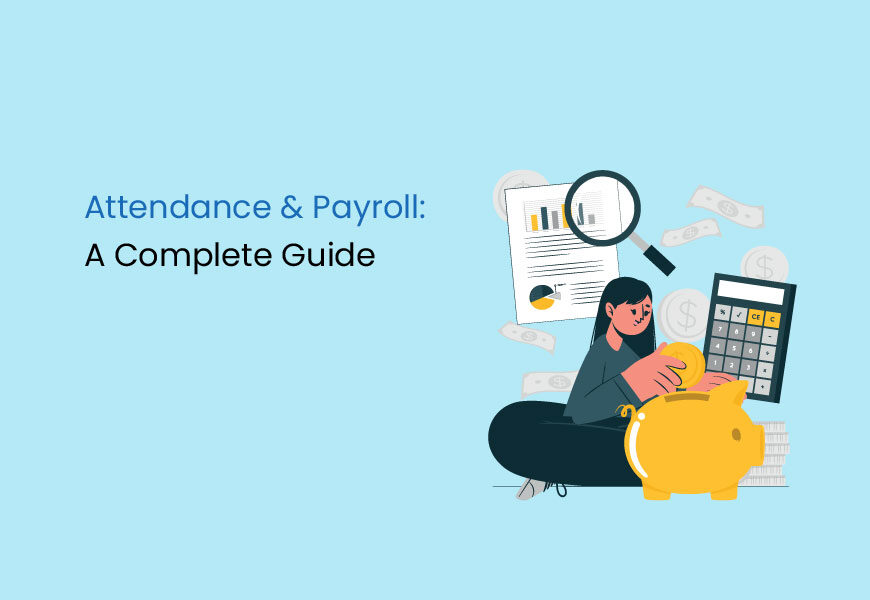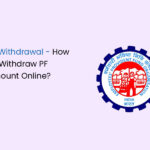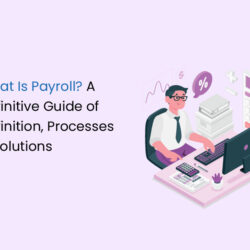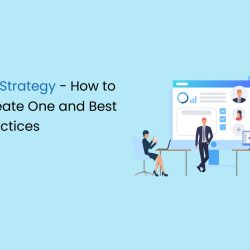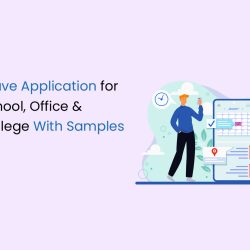Attendance & Payroll are critical to every organisation, no matter what their size or scale of operation or which industry they operate in. After all, properly managing attendance and payroll ensures that employees are paid accurately on time while being compliant to all regulatory requirements. Further, they help maintain productivity, track performance and ensure better allocation of resources. Proper payroll and attendance management also help improve transparency and accountability within the organisation.
Despite their importance to the organisation, effectively managing payroll and attendance is rather challenging, especially when done manually or using rudimentary tools. So, how exactly should payroll and attendance be managed? Keep reading this comprehensive guide to know more about attendance and payroll, the need for payroll and attendance software, types of software available and how to find the right one for your organisation.
What Is Attendance & Payroll?
Attendance and payroll are two crucial aspects of the HR function. But they aren’t restricted to the HR department alone; they require collaborative efforts from both the HR and finance departments. In some cases, the organisation may have separate payroll teams that will have to collaborate with the HR and finance teams for the effective management of payroll and attendance.
Attendance, as you may already know, is the record of an employee’s presence and absence from work. It involves the tracking, monitoring and documentation of the number of hours an employee has worked in a given time period, including any leaves, vacations or absences taken.
It also requires the organisation to track the time an employee arrives and leaves the workplace including late arrivals, early departures, overtimes and instances of tardiness. Attendance management encompasses the processes and systems used to track and manage employee attendance, productivity, compliance with leave policies, and work schedules, among others.
Payroll refers to the process of calculating and disbursing compensation including wages/ salaries, social security, bonuses, commissions and other benefits to employees for a specified period of time. Payroll management starts with the preparation of the list of employees to be compensated and ends with the documentation of expenses.
Payroll management includes:
- maintaining up-to-date records of all employees in the payroll including direct and indirect employees.
- the determination of the total amount of money to be paid to each employee based on their attendance records.
- the calculation and deduction of taxes and other statutory deductions such as health insurance, PF contributions, ESI contributions, labour fund deductions, benefits, etc.
- making payments to employees in a timely and accurate manner through pay cheques, cash or direct deposits.
- ensuring compliance with all statutory compliance requirements of the state and central governments.
- payment of all statutory dues to appropriate authorities/ government organisations within the stipulated time period and filing returns, where necessary.
- documentation and reporting of employee compensation expenses.
Why Should You Use Attendance & Payroll Software?
There are a number of ways in which organisations can manage their attendance and payroll. Typically, manual methods and rudimentary tools such as spreadsheets are used by employers to monitor and manage attendance and payroll. While these methods are cost-effective, they bring several challenges.
- They are time-consuming and inefficient, taking up several hours of employee bandwidth. While smaller businesses and home-based businesses may be able to manage with a single person working on payroll and attendance, others will have to either deploy large teams or outsource to external agencies. These large teams are engaged in hours of busywork and repetitive manual tasks, instead of focusing on core business functions.
- Manual and spreadsheet-based attendance and payroll management are not scalable. When a business has only a handful of employees, these methods may still work. However, as they grow and have the number of employees increase, these methods are ineffective and don’t scale well.
- These methods are inaccurate with high risks of errors of omission, calculation errors, human errors, duplication, compliance errors and so on.
- Every employer needs to make a number of statutory and other deductions from salaries. Each of these have different contribution/ deduction rates which makes the whole process complicated.
- Employers employ different types of workers such as white-collar workers, gig workers, temporary workers, contractual labourers, informal workers and so on. Each of them is paid differently with varying rates of deductions.
- For instance, platform gig workers such as drivers, delivery persons, etc. are paid for each ride/ delivery. So, all their trips and time spent needs to be monitored to properly calculate their total weekly/ monthly payout. Based on this payout, their monthly TDS and social security deductions will differ.
- These methods are not flexible and agile. Whether one wants to update employee data, add/remove employees, etc., it is hard using manual methods and spreadsheets.
- The compliance landscape and requirements keep evolving. It is not possible to keep pace with and adapt to these changing requirements using manual and spreadsheet-based attendance and payroll management. This leads to non-compliance, which has financial and legal consequences for the employer.
Organisations also enlist the services of external agencies to take care of their attendance and payroll, especially when they do not have specialised payroll or HR experts. Outsourcing of payroll and attendance helps employers to steer away from the challenges posed by manual and spreadsheet-based management. However, this method can be expensive and the organisation may not have complete control over expenses. This method also brings governance challenges and transparency risks.
The Best Method for Attendance and Payroll Management
One of the best methods to manage attendance and payroll is the use of purpose-built, straightforward and comprehensive software/ apps such as TankhaPay. These systems enable employers, regardless of their size, scale and nature of operation, to effectively and accurately track, monitor and manage the various payroll and attendance management processes.
Here are all the reasons employers should choose attendance and payroll management software.
Simple and Straightforward to Use: These software leverage automation and other advanced technologies such as AI, ML and analytics to drive greater efficiency, accuracy and cost-effectiveness into the process. For smaller businesses and even individual households, it becomes much simpler and straightforward to manage their payroll and attendance.
Accuracy and Efficiency: Attendance and payroll management software help ensure highest levels of accuracy and efficiency. Automation ensures that your internal teams do not have to engage in manual drudgery or time-consuming paperwork. It tracks attendance, calculates salaries, payouts and deductions based on pre-defined parameters with minimal need for human intervention. It is scalable, flexible and agile, growing with your organisation and helping you to adapt seamlessly with the changing regulatory environment.
Centralization of Data: Payroll and attendance software help integrate employee data from across multiple locations. For instance, platform workers such as delivery persons, runners and drivers are dispersed at various locations across the city and the country itself. With this software, the employer can centrally monitor and track the movement and working of all their gig workers centrally. This minimizes the possibilities of errors and inaccuracies. Data centralization further ensures better collaboration between the multiple departments that manage payroll and attendance.
Employee Self-Service: The best payroll and attendance software offer this feature. This has twin advantages – one, the employee can follow up on their attendance, benefits, deductions, payments, etc. without cumbersome paperwork or trips to different departments. Two, it ensures greater transparency and helps establish a sense of trust in employee-employer relations.
Ensuring Compliance: Attendance and payroll software enables employers to meet all statutory compliance requirements with ease, from timely and accurate salary/ wage payments and depositing deductions to generating reports and filing returns.
Real-time Monitoring and Control: Attendance and payroll software enable employers to monitor and track employee attendance, productivity, absence, etc. in real-time and generated over a period of time. This enables them to take corrective action, if necessary.
Insights and Reports: The other important reason employers should use payroll and attendance software is that it helps generate accurate and comprehensive reports and insights on employee attendance, absence, payroll, productivity and much more. Using these insights and reports, employers can optimize budgets, take steps to improve employee productivity, make informed policy decisions and so on.
Click Here For: ESI Calculation and Contribution Rate 2023
Types of HR Software
As mentioned earlier, attendance and payroll are HR functions at their core, despite the need for collaboration with other departments. Payroll and attendance along with other HR functions in more comprehensive HR software. But they can also be availed as a separate specialized software for each HR function. In this section, we are discussing the 4 types of HR software available.
HR Management Software
This is a comprehensive software solution that enables employers to manage all aspects of HR in one centralized app. It centralizes employee data, automates HR processes, and provides functionalities such as employee self-service, applicant tracking, time and attendance tracking, payroll, onboarding, performance management and reporting, among others.
Employee Self-Service
Employee self-service software is a type of HR software that allows employees to access and manage their own information related to employment, payments, benefits, attendance, leave, etc. and perform self-service tasks. It provides a user-friendly interface for employees to view and update their personal details, access HR policies and documents, request time off, view pay statements and perform other HR-related activities without having to rely on HR staff.
Employee Onboarding
This HR software assists employers with the hiring and onboarding of selected candidates including job listing, interview management, new employee training and onboarding formalities (paperwork, document submission, verifications, etc.), among others.
Payroll Software
This HR software is more specialized and focuses only on the management of payroll. It automates payroll processing for employers and enables them to calculate salaries and make timely, accurate payments to all their employees. This software also provides self-service options for employees to access their payroll information.
Tankha Pay is a unique app that provides all 4 of these services.
Steps To Finding the Right Software for Attendance & Payroll
It is critical that you carefully research available attendance and payroll software options and make the right choice. Choosing the wrong software will not only be a wasteful expense but could also land you in a legal, reputational and compliance mess. Here are the 3 key considerations to make while choosing your payroll and attendance software.
Define Your Core Business Processes and Requirements: This must be done even before shortlisting HR software. You need to know what your core business processes and requirements are to ensure you choose a software that can offer you those services. For instance, you may need software that lets you not only manage attendance and payroll but manage social security benefits and onboarding of employees. And you may have a budgetary constraint too. Defining these requirements will help you to choose the right software.
Assess Current Processes: Shortlist potential solutions to check if they can help you automate your business processes. Don’t just go by what the vendor promises.
Examine Vendor Offerings: Look at all the offerings from the vendor to ensure they are comprehensive, easy to use and not cumbersome, help with meeting compliance requirements and fit within your budget.
How Tankhapay Can Help You?
Given how important attendance and payroll are, TankhaPay app provides the simplest, most straightforward solution to all employers, no matter their scale of operation, in managing these.
TankhaPay is a comprehensive and easy-to-use app that enables employers to extend social security benefits to all their employees including informal workers (household staff, peons, temporary workers, gig workers, casual labourers, etc.) while effectively managing attendance, payroll, onboarding and compliance. Additionally, with TankhaPay, employers using the app do not have register themselves with PF and ESI either!
Also Read
- Payroll Process – Basics, Requirements, Compliances
- HR Policies – A Roadmap for Organisational Success
- What is Payroll Management System? – Definition and Importance
